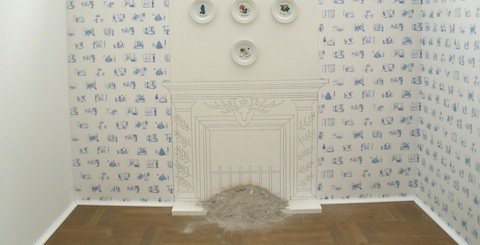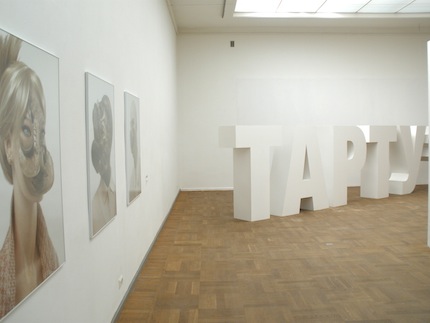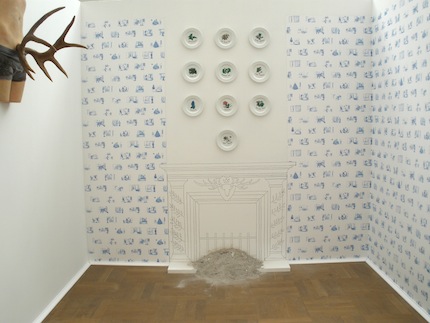
The Toxic of the Exotic in Tallinn
Liisa Kaljula
05/06/2012
Exhibition “The Exotic” was on view in Kunstihoone, Tallinn, through June 3
The Exotic is Kirke Kangro's second curatorial project in Kunstihoone since Revenge. If I were in charge, I would kindly ask her to curate a third one, just to see where this post-colonial narrative is heading, as trilogies tend to be incriminatingly revealing here. Both of the shows touched on the issue of using power, and the resulting outcomes: the peculiar, at times seductively bizarre, at times frighteningly grotesque, flowers of power. Edward Said wrote about the strong connections between exoticism, the cultivation of the charm of the unfamiliar, and the maintaining of the ruling position between East and West in his book Orientalism (1978). Contemporary anthropologists have suggested that exoticism can be seen as a desire of one culture to consume the other – for delight. This ambiguity is also present in The Exotic, as it moves around certain cultural concepts or keywords of the contemporary world in a distinctively essay-istic way, cherishing the concept of the exotic here and criticizing it there. The exhibition has been turned into a space for contemplation – in cities, this is one of the few such places left, where the visitor can slowly fill herself or himself with different inscriptions to the topic.
The Exotica not only symbolically, but literally, begins with such inscriptions. Denes Kalev Farkas' piece on the wall of the central hall works as a dictionary inscription of associations for the Greek word εξωτικός: yearning, stimulation, sense, alien, suffocate, resemble, idiosyncrasy. Kiwa`s Glitter Text is just nearby, written on the entrance wall with beaming letters and glam-punk attitude. This illogical greeting could be taken as a teaser at the door of the exhibition: “Hey, you, seekers of exotica, feeders of your modern, hungry souls, thirsty for glitter and glamor!” But let's be honest – there is something for everyone here, excitement-seekers get their fair share, as do the ones who feel the need to reflect on the widespread thirst for the new: Why are we so hungry for stimulus these days? Is it the gluttonous consumer society that makes us so insatiable? A comment written in the guest-book of the exhibition gives the exhibition a top rating – awesome – even though the guest then adds that it would have been even more awesome if there would have been snacks included. Exotic snacks! But they were included, actually...

Jan Manski at the foreground and Taavi Talve and Denes Farkas at the back
The Section of Curiosities
Jaanus Samma shows us grains of earth consisting of medallions that represent different far-away countries: China, the Vatican, Turkey, and France. The grains of earth, however, seem to be local – but hey, it is cheap, and it is attainable! Jan Manski, in his growing, total work of art – Onania, comments sarcastically on the narcissistic, non-stop, pleasure-seeking modern self. There's something sinister – comparable to the bored aristocracy – in his joyful play of imagined genetic mutations mixing human and reptile origins. And his Onania seems to be growing bigger and bigger; the three-piece photo in a reduced color scale seen in Kunstihoone, is only one little part of it. Right next to it stand shining white, monumental sculptural letters by Taavi Talve and Denes Kalev Farkas that read ТАРТУ, orientalizing the name of the second largest city in Estonia, thus making the most out of the never-ending rivalry and chafing between the capital city and the university town. The main hall of The Exotica is almost clinically hygienic, clean, and calm. Whereas the dark, black box showing videos by Anssi Kasitonni and Minna Hint is anything but hygienic, clean, and calm. It's lovely the way that the space starts to work in this exhibition, by supporting interactions between different authors.

Jan Manski
The Section of Atrocities
Kennard Phillips is a collaboration against the Western invasion of Iraq that shares its message via several artistic media, in different contexts, across the globe. In Tallinn we can see a photo-montage of a boyishly excited Tony Blair making a portrait of himself with explosions in the background, while using his mobile phone device. Edward Said's original concept of orientalism – the constantly reproduced image by the West of the East as a savage and young place, used in order to keep up the father and child relationship – could well be be applied here. Tone Kristin Bjordam's Coral evokes parallels with the atomic bomb explosions and their damningly unearthly beauty: how can something so terrible seem so beautiful? Nature uses mimicry extensively, by hiding the most poisonous contents in the most seductive forms. This hoax that plays on weaknesses keeps things moving, never letting the status quo settle for too long of a time. Bjordam's video set is, by the way, permanently installed on the cruise ship Celebrity Equinox, which drifts on the Mediterranean, offering its well-off clientele an exclusive vacation with piquant pleasures. Marko Mäetamm is continuing his survey of le charm discret de la bourgeoisie with his installation Walking in My Hunting Ground. The family's father is presented as a hunter who, as his children describe him, “has a good nose. He finds out everything! He finds everybody! There is no chance to hide. Here he comes – our daddy!” One of the remarkable things about Mäetamm is the way he uses signifier and signified complementarily, never wholly overlapping one with the other. While the signified is cynically cruel, the signifier is sweet – as only children can be. An interesting form of artistic hypocrisy that twistedly supports Gandhi's suggestion that to live a good life, one should keep a harmony of words, deeds and thoughts.

Marko Maetamm
The Section of Rarities and Banalities
Taavi Piibemann`s Estonian Exotic is a quote from the Estonian prime minister that caught the artist's eye in the daily media: I was mistaken. The old human incapability to admit ever being wrong, but in the light of recent developments in the Estonian political landscape – a young politician of the Reform Party, who admitted to accepting sums of unknown origins in exchange for getting the party to suggest a change in the political culture, has been rejected by the party – the work becomes ever more politically loaded. Culture, in the widest sense, is a mighty thing; it sets standards for behavior, creates the mainstream and its sub-streams, its center and its periphery. Silja Saarepuu's and Villu Plink's video shows the last Estonians, peculiarly and clumsily rolling around a windy ice field with archaic wooden rolling-pins, thereby presenting the keeping of traditions as a hopeless fight kept up by the stubborn ones. Toomas Thetloff has created a naturally flavored Perfumed Passage between two exhibition rooms, which fades away with each visitor and has to be refreshed every morning. Cory Arcangel has illustrated the concept of exotica in his graphic series with three carelessly-sketched and easily-reproducible palm trees. The economy that sells exotica is profiting hugely from the banalities that the wing-stripped imagination of the mass media offers. Kai Kaljo sells souvenirs of Tallinn that don't really differ from those of any other place, thereby taking a critical look at the global souvenir industry. Machine translations, as if these are the only options left to save something that is fading away, are offered by Raul Keller (Black Music Box) and Kiwa (The Translation Exotic), while Yang Li (Mustard Seed Forest) has gone through the process the other way around, by painting landscapes again – slowly and by hand, using the old and forgotten traditions that are locked in books – but also integrating materials from the plastic age.